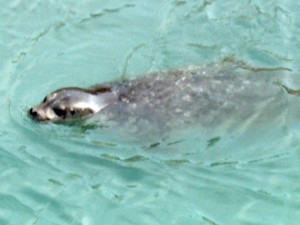 We are in Glacier Bay. The cruise liner “Zuiderdam” is sailing at low speed, showing off the unforgettable beauty of the nature: everywhere the blue ice mountains, icebergs popping out of the turquoise water, slams of snowy ice are floating here and there following the ship. It is cool here. We dressed up in warmer clothesand went out on the promenade deck to watch the nature.
We are in Glacier Bay. The cruise liner “Zuiderdam” is sailing at low speed, showing off the unforgettable beauty of the nature: everywhere the blue ice mountains, icebergs popping out of the turquoise water, slams of snowy ice are floating here and there following the ship. It is cool here. We dressed up in warmer clothesand went out on the promenade deck to watch the nature.
“Do you hear the quietness, Mom?” asked Larisa addressing me. “Yes, I do.” I answered.”It reminds me the music performed by Maestro Paganini on the only one string of his masterpiece violin while the others were broken off.
I listened to the quietness, so did the other people a gawk of the Glacier beauty. The quietness put spells on all who were present at the moment. Everybody kept silent. The goodness of coolness, unusual change of colors and hues of ice and water-all emerged into one musical harmony which no one composer in the world could put into music-symphony of the frozen quietness of Glacier Bay. Do you hear this music? Yes, it is inside us. Not a single binocle might help to enlarge the picture, increase the sensations. One does not need the binocle. The music is flowing crescendo, that is within us: the music of awe and beauty of the Glacier formations.
This is our photo report “Glacier lives, Glacier floats, Glacier rejoices us with Its Eternal Presence!”:
It’s hard to believe that 250 years ago, Glacier Bay was all glacier and no bay. A massive river of ice, roughly 100 miles long and thousands of feet deep, occupied the entire bay. Today, that glacier is gone, having retreated north. Fewer than a dozen smaller tidewater glaciers remain. Impressive in themselves, sequestered at the heads of their inlets in the upper bay, they flow from tall coastal mountains to the sea, and calve great shards of ice that bejewel cold waters with diamond-like bergs. They are witness to change, these rivers of ice. They invite us to slow down and breath deeply of the cool ice age air, and to imagine, if only for a day, the way things used to be.
than a dozen smaller tidewater glaciers remain. Impressive in themselves, sequestered at the heads of their inlets in the upper bay, they flow from tall coastal mountains to the sea, and calve great shards of ice that bejewel cold waters with diamond-like bergs. They are witness to change, these rivers of ice. They invite us to slow down and breath deeply of the cool ice age air, and to imagine, if only for a day, the way things used to be.
Did you hear the music of the Glacier? Immerse in it and enjoy!
Cruising Alaska’s Inside Passage we entertained ourselves with observing sea animals and birds behavior: seals, humpback whales, pigeons guillemot, sea gulls, sea stars…
 Leaving the Glacier Bay the thick fog fell down, it seemed there is no visible sign of anything that we’ve seen before. Look around! All disappeared as if by a magic wand of Lady Fairy. Depressing impression grew on and on when the cruise liner started to whistle every two minutes-alarming signal. The ship sailed on the whole night alarm whistling just laying her route by the navigation devices. A little bit scary.Remembering the sad experiences of “Concordia”‘s collision near Chivitavekkia, I kept all my frightening thoughts to myself avoiding to spread the panic among my family. Thank Goodness, everything was all right next morning.
Leaving the Glacier Bay the thick fog fell down, it seemed there is no visible sign of anything that we’ve seen before. Look around! All disappeared as if by a magic wand of Lady Fairy. Depressing impression grew on and on when the cruise liner started to whistle every two minutes-alarming signal. The ship sailed on the whole night alarm whistling just laying her route by the navigation devices. A little bit scary.Remembering the sad experiences of “Concordia”‘s collision near Chivitavekkia, I kept all my frightening thoughts to myself avoiding to spread the panic among my family. Thank Goodness, everything was all right next morning.
The weather was fine inside the Passage , we are seeing the beauties of Tongass National Forest, passed John Hopkins Glacier, Hubbard Glacier Glacier, recollecting good job having done by ecologist William S. Cooper and John Muir. Captain George Vancouver had said the area in 1794, and created a rough map that showed the bay filled with a single great glacier. Eighty five years after Vancouver, naturalist/preservationist John Muir had visited the bay by canoe, and found the glacier receding as fast as mile per year.. Muir wrote about Glacier Bay with such lyrical heart-the words like music-that he changed America’s national perception of Alaska from one of daunting cold to enchanting beauty.
Watch our video: “Alaska, Glaciers 2012”
